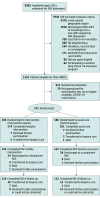Deprescribing Medications Among Older Adults From End of Hospitalization Through Postacute Care: A Shed-MEDS Randomized Clinical Trial
- PMID: 36745422
- PMCID: PMC9989899
- DOI: 10.1001/jamainternmed.2022.6545
Deprescribing Medications Among Older Adults From End of Hospitalization Through Postacute Care: A Shed-MEDS Randomized Clinical Trial
Abstract
Importance: Deprescribing is a promising approach to addressing the burden of polypharmacy. Few studies have initiated comprehensive deprescribing in the hospital setting among older patients requiring ongoing care in a postacute care (PAC) facility.
Objective: To evaluate the efficacy of a patient-centered deprescribing intervention among hospitalized older adults transitioning or being discharged to a PAC facility.
Design, setting, and participants: This randomized clinical trial of the Shed-MEDS (Best Possible Medication History, Evaluate, Deprescribing Recommendations, and Synthesis) deprescribing intervention was conducted between March 2016 and October 2020. Patients who were admitted to an academic medical center and discharged to 1 of 22 PAC facilities affiliated with the medical center were recruited. Patients who were 50 years or older and had 5 or more prehospital medications were enrolled and randomized 1:1 to the intervention group or control group. Patients who were non-English speaking, were unhoused, were long-stay residents of nursing homes, or had less than 6 months of life expectancy were excluded. An intention-to-treat approach was used.
Interventions: The intervention group received the Shed-MEDS intervention, which consisted of a pharmacist- or nurse practitioner-led comprehensive medication review, patient or surrogate-approved deprescribing recommendations, and deprescribing actions that were initiated in the hospital and continued throughout the PAC facility stay. The control group received usual care at the hospital and PAC facility.
Main outcomes and measures: The primary outcome was the total medication count at hospital discharge and PAC facility discharge, with follow-up assessments during the 90-day period after PAC facility discharge. Secondary outcomes included the total number of potentially inappropriate medications at each time point, the Drug Burden Index, and adverse events.
Results: A total of 372 participants (mean [SD] age, 76.2 [10.7] years; 229 females [62%]) were randomized to the intervention or control groups. Of these participants, 284 were included in the intention-to-treat analysis (142 in the intervention group and 142 in the control group). Overall, there was a statistically significant treatment effect, with patients in the intervention group taking a mean of 14% fewer medications at PAC facility discharge (mean ratio, 0.86; 95% CI, 0.80-0.93; P < .001) and 15% fewer medications at the 90-day follow-up (mean ratio, 0.85; 95% CI, 0.78-0.92; P < .001) compared with the control group. The intervention additionally reduced patient exposure to potentially inappropriate medications and Drug Burden Index. Adverse drug event rates were similar between the intervention and control groups (hazard ratio, 0.83; 95% CI, 0.52-1.30).
Conclusions and relevance: Results of this trial showed that the Shed-MEDS patient-centered deprescribing intervention was safe and effective in reducing the total medication burden at PAC facility discharge and 90 days after discharge. Future studies are needed to examine the effect of this intervention on patient-reported and long-term clinical outcomes.
Trial registration: ClinicalTrials.gov Identifier: NCT02979353.
Conflict of interest statement
Figures


References
-
- Huang ES, Karter AJ, Danielson KK, Warton EM, Ahmed AT. The association between the number of prescription medications and incident falls in a multi-ethnic population of adult type-2 diabetes patients: the diabetes and aging study. J Gen Intern Med. 2010;25(2):141-146. doi:10.1007/s11606-009-1179-2 - DOI - PMC - PubMed
Publication types
MeSH terms
Associated data
Grants and funding
LinkOut - more resources
Full Text Sources
Medical

